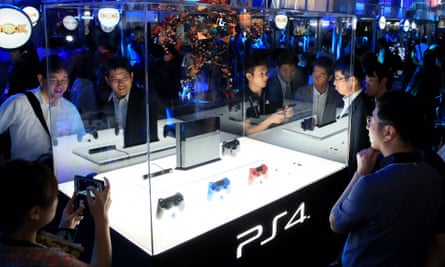The secret to rekindling Sony’s return to form, according to the company’s chief executive, is personalisation – achieved not by the mass collection of customer data in the way some big tech firms do, but by eliciting an emotional response to its products.
“Getting in close is the only way,” says Kaz Hirai, who took the helm of Sony five-and-half-years ago charged with turning the company around; he has succeeded, with Sony projecting its largest-ever annual operating profit of £4.2bn this year. Hirai is a passionate believer in the Japanese concept of Kando, which is about establishing an emotional connection across what Sony calls “the last one inch” to the consumer – the wow factor that creates enthusiasm and loyalty.
“My father and grandfather were Sony fanatics,” he says. “When I was about five years old, my father recorded my voice on his open reel tape deck and played it back. Hearing my own voice was a technological wonder.
“We had a huge TV, but we also had a five-inch TV, and I found it wonderful that Sony could miniaturise these products.”
But by the time Hirai took over as chief executive that wow factor had faded.
“Sony products need to have functional and emotional value,” says Hirai, who made it his mission to apply Kando across every business unit and revive faded glory. “Anybody can provide functional value in this commoditised space, but emotional value is something that has been part of the Sony design philosophy, part of the Sony DNA since the company started 71 years ago. We kind of lost it for a while, and my job has been to revive that pride in what we do in terms of providing emotional value.”
Aibo, Sony’s revived robotic dog, embodies Kando, showcasing Sony’s AI and robotics by replicating some of the endearing qualities of a real dog. Aibo can recognise faces and voices, while sensors on his head, chin and back mean that it responds physical stimuli.
Hands on fire-fighting

“If there’s a challenge, organisationally or financially, I have to get in there and do it myself,” Hirai says. “When businesses are running well, we have fine executives who can run them day to day. But when the fires are up, somebody’s got to get in there and do the hard work, stop the fires and turn the business around.”
Hirai’s hands-on approach to leadership extends to the highly-charged environment of Hollywood, which has been rocked by the recent sexual harassment scandals, where he sought to extend Sony’s positive corporate culture following Sony’s own damaging leaked email scandal in 2014.
“At Sony, we have absolute zero tolerance not just for sexual harassment, but for any type of harassment,” he says. “We want to provide a safe, comfortable and trusting environment for our employees all over the world.
“We have about 120,000 employees and we have policies in place to ensure that employees and management understand that we have zero tolerance for any of this stuff and if there are infractions, employees should feel comfortable reporting them to management as quickly as possible in the knowledge that each and every one of these incidents will be investigated, and if appropriate action needs to be taken, it will be taken very swiftly. We have a good policy in place, and we continue reinforcing it.”
From February to August last year, when Hirai was looking for a new head for Sony Pictures Entertainment following the departure of Michael Lynton to Snapchat, hespent two weeks a month at the studio in Culver City, California. “I wanted to get to know the business better,” he says. “I wanted to be able to have an intelligent dialogue with potential candidates so that I could answer their questions and say here are some things I expect you to do.”
While he was there, he took the opportunity to walk the floor, meeting rank-and-file employees to understand their issues and motivations. “Sony Pictures is a big lot, and I didn’t want to zip by in a golf cart. I wanted people to see me walking from one end of the studio to the other meeting and greeting employees.”
“Through these interactions, I got the message across to them that the president of the organisation from Tokyo was willing to spend two weeks a month getting to understand it and finding it the right CEO. And the culture at Sony Pictures Entertainment has shifted because people understand that Tokyo has got their back.”
Great design should remain unchanged

Hirai has turned around every business he has led. In 2006, when he became president of Sony Computer Entertainment, PlayStation reported losses of ¥230bn following the PS3 debacle. Hirai turned the business around and brought in new management, who produced the phenomenally successful PS4.
Central to Hirai’s strategy is creating enduring brands, which involved shifting Sony’s design culture. When Hirai became chief executive, as is typical in consumer electronics, every product iteration would include a redesign.
“I sat down with the managers of each major product category and said to them, ‘if you think it’s a great design, don’t change it. Be proud of what you did, and be proud enough to stick with it.’
“It’s a cultural change that we brought about. It shows Sony’s respect for the products we make. If it’s good enough for the customers, it should be good enough for us not to change designs every year. That is how we create emotional value.”
This approach has proved particularly effective with the company’s high-end RX cameras and headphones brands. But away from consumer electronics, Sony’s focus has shifted towards AI and robotics, image sensors (via its semiconductor business) and PlayStation, which has 70 million users worldwide.
Hirai is not complacent about PlayStation’s lead in gaming or Sony Pictures’ string of hit movies. “Sony Pictures has had some great hits this year, but they need a sustainable model. We had a hit with Spider-Man [Homecoming] last year, and that means that we get to do a lot of business with DVDs, Blu-rays and licensing of Spiderman this year and beyond. How successful you are or not in year one determines the business in year two and year three going forward, and then it’s staggered. It is a complex business.”

The company is seeking new applications for its AI, sensors and robotics in autonomous vehicles. The firm says, for instance, that its market-leading image sensors can help vehicles “see” better than humans, with wide-angle lenses for better visibility and the ability to adjust instantly to low or changing light conditions.
Hirai announced partnerships with leading automotive manufacturers at CES in Las Vegas, but admits that this is still a nascent venture that isn’t expected to bring in revenue for several years. “For now, the main drivers of the image-sensor business are smartphones, digital cameras and some surveillance and IoT [Internet of Things]. We need to make sure that we have a stable business today so that we can segue into the automotive tomorrow.”
Sony’s image sensors are used in leading smartphone brands – Hirai jokes about supplying “little” companies in Cupertino, South Korea and China – but its own smartphones struggle outside Japan.
Some have suggested Sony Mobile should throw in the towel, but Hirai disagrees:
“The reason we’re doing that is not because we think smartphones are the future, but because we have to have some devices connected to a network in order to communicate. If we get out of the [communications] space, we won’t have the opportunity to play in the next paradigm shift.”
“It’s not about the smartphones of today; it’s more about looking beyond smartphones – at what are we going to be doing – and to be a player in this space; ideally to be a leader. For that strategic reason, I want to make sure we stay, not in the smartphone business, per se, but in the communications business.”
Sony’s restructuring appears to be paying off, reporting what analysts called “blowout results” for the second quarter based on a mix of old and new business, and projecting full-year profits up 20% on last year - quite a change from an organisation in decline reporting £3bn losses when Hirai took over.
But he is not complacent: “This is not the time to be doing a victory lap because we still have another quarter to go before the end of the fiscal year. We have to make sure we hit the numbers or even do better. That’s job one. Job two is to ensure that we don’t fall off the cliff next year, as we’ve done that in the past.”
While Hirai may not believe that smartphones are the future, and his focus for 2018 is sustainable profit, Sony is still open to new technology, whichever path that takes.
“We need to make sure we are proactively investing for future businesses in terms of technology as well as business models, so that we can leave the company in better shape as we hand it off to the next generation,” said Hirai.
